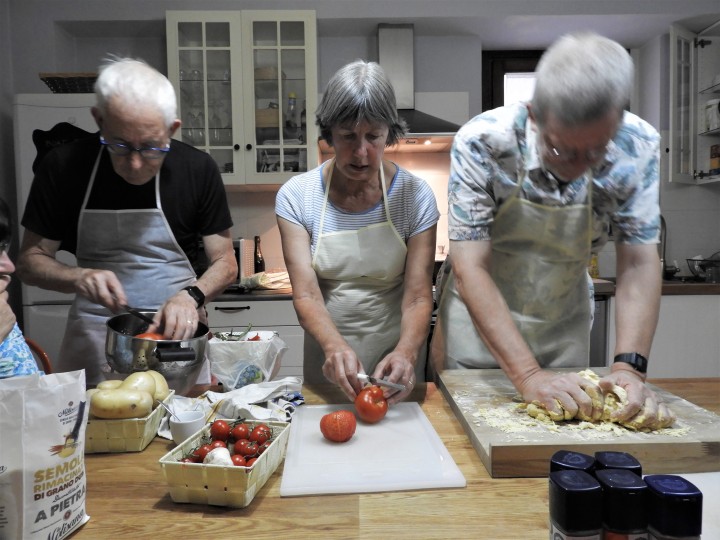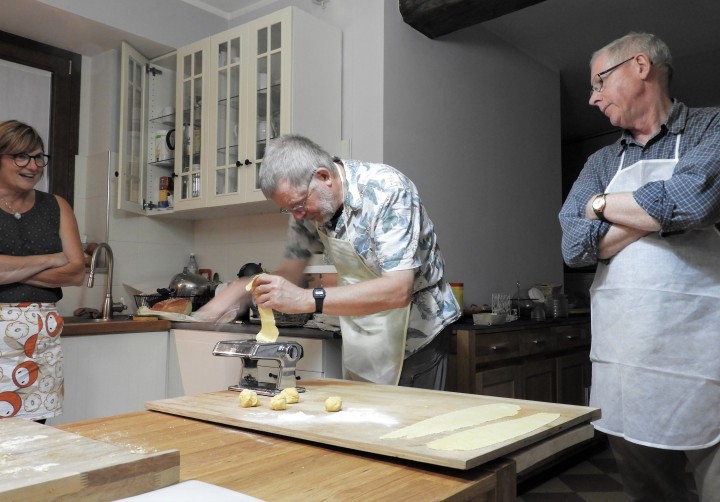We stepped into a courtyard past a colossal seventeenth-century wooden door. Silvia poured water into pretty coloured glasses and started talking and laughing immediately. ‘We have a meat dish that’s very traditional to this area. The story goes that the Roman soldiers of long ago had nothing to eat – except for wine and garlic – people always had wine and garlic, even if they had nothing else. Desperate, the Romans threw their poor horse into the pot and a local delicacy was born. But we are not going to eat horse. Whenever I say this, I see people looking at me with eyes like yours’. She laughed again. We relaxed and were hooked. Silvia had our full attention.

We were here to cook. And then to eat. And it seemed to be entertained. We moved into a bright, white kitchen and were immediately put to work. Val and I peeled pears. Silvia tipped sugar, cinnamon, cloves and orange into a pan. And red wine. The bottle glugged and glugged again and we were all drowned by the smells of Christmas. There was no measuring, because ‘cooking should be stress free’, said Silvia. She judged by sight, smell, taste and years of experience. The pears simmered, turning a gentle rosy shade of red, as they enjoyed the wine.
We started on the horseless horse-meat dish. Nick chopped a small mountain of garlic. The beef was unwrapped. Another bottle of wine went into another pan. ‘It is our wine and very good’ said Silvia as she passed the bottle around so we could all smell. ‘We will be tasting this later’, she laughed. What a tease! Silvia added a ‘pinch’ of salt. Glug, gulp, glug went the olive oil bottle. We all looked at each other. ‘I don’t normally use this much, but if there are a lot of people, like we are, we need a lot’. For the next two hours, the meat simmered in it’s nest of garlic, bay leaves and wine.
Dolce – check. Secondi – check. Time to turn our attention to the primi – pasta. ‘You can make ravioli or tagliatelle’, said Silvia. ‘Both’, we all chorused. We were getting our chef heads on now.
‘The rule is one egg for two people’, said Silvia, ‘but it depends on the size of the egg’. More guesswork. Jim mixed eggs and flour and made a sorry looking dough. Dry and crumbly, it somehow also managed to stick to his fingers, so he looked like he was wearing doughy boxing gloves. For the next half hour, he huffed and puffed, kneaded and pummelled and was the butt of our jokes. ‘Nothing is happening’, he said. ‘Yes, it’s changing’, we cried, ‘keep going’. ‘You can do it with a machine,’ said Silvia, ‘but this is more fun’. Jim chuntered under his breath. Meanwhile she piled spinach into a pan, added olive oil and salt, and once cooked it was mixed with ricotta. Jim was building muscles like Popeye. Eventually Silivia took pity on him, added a splash of water and the dough came together immediately. ‘It’s because it’s very windy today. It makes the pasta dry. Yesterday we had the opposite problem – it was so hot, the pasta was sticky’.


While the pears and meat simmered away in their wine baths and the dough rested, we drank wine and tasted cheese. Fresh ricotta -soft, creamy and light – with a dark, syrupy honey laced with chestnut, or with olive oil and salt; a local hard cheese called La Tombe and then a humongous doorstop of Gorgonzola – so weighty Isabelle needed both hands to heft the board. ‘You always need to serve Gorgonzola in the wrapper, otherwise it just runs away’, laughed Silvia. Locals are mad about Gorgonzola – the town is not very far away, in between Milan and Novara. ‘We can just keep eating it, you take a piece and then you take a bit more…. and Silvia’s voice trailed away. I too could have just kept eating, but I knew we had the pasta, the meat, and the pears to come.

The dough – and us – had had enough of a rest and Silvia herded us back to the kitchen. Now pulled into smaller pieces the dough was forced through the pasta machine – several times on different settings. We all had a go, concentration marking our faces, rolling until we had a long thin strip,which was filled with our ‘spinaches’ as Silvia called them, and cut with a wheel. No holes. No air. Silvia’s ravioli were beautiful, neat packages. Ours were deformed – big, bigger, biggest squares. ‘One of those is a meal’, laughed Silvia. We were taking so long, the pasta was becoming dry again and unworkable. Pasta grannies we were not!

Next tagliatelle. Our version of. For centuries the exact width of tagliatelle has been argued over. Invented on May 28 1487 (!) by the great cook Mastro Zafirano as a homage to Lucrezia Borgia’s blonde tresses, in 1972 a gastronomic law decreed that one tagliatella should measure one 12,276th part of the Torre degli Asinelli – ie. 8mm. Before it goes in the pot it must be no more than 6.5 or 7mm, so as to allow it to swell to it’s required 8mm. Silvia took over production at the end – otherwise we may have been eating dinner at breakfast – so perhaps our tagliatelle would’ve passed.
‘Do you always make fresh pasta?’we asked. It seemed like a huge labour of love. ‘Not every day’, Silvia admitted, ‘but when friends visit I do. It just tastes better’.
The pears had been turned – laid on their sides – ‘simply for colour’ and chopped potatoes were laid on top of the bubbling meat to cook in the steam. The water was put on for the pasta. We were almost there.
Dinner was about to be served!
Practical Stuff.
We did our cooking lesson with Silvia Padulazzi. She lives in Omegna at the northern end of the lake. Lessons begin at 17.00 and finish at 21.00. Price Euro 68 p.p. (min. charge Euro 200). Price includes all ingredients and dinner. http://www.yourhandson.wordpress.com
How fabulous!
LikeLike
It was such a laugh Sheree, and even though I do say it myself – also delicious!
LikeLiked by 1 person
What a great experience among friends. I’m sure there were many laughs that day! 🙂
LikeLike
Lots, Lorelle!
LikeLike
It is really fun cooking with friends, and I think it is one of the most unforgettable experience in your life. 🙂
LikeLike
You’re right Megala! The only thing better than cooking with friends is eating with friends!
LikeLiked by 1 person
What a beautiful experience! I love homemade pasta, though I don’t get to eat it very often (too much work). But it looks like you really worked up an appetite 🙂
LikeLike
Jim certainly did!
LikeLike
Well this sounds like fun. Glad I read it after dinner and not before!
Alison
LikeLike
It was great to do with friends, Alison. We’ve done cooking lessons before – alone, or with people we didn’t know – but with friends, it had that extra something.
LikeLiked by 1 person
What a wonderful post ~ as someone who loves food and loves cooking, I really enjoyed the photos and your terrific description of the whole experience. Such a great activity to do as a group! I think there is always a different type of appreciation for certain dishes after one tries to make them them oneself and also just seeing the process…
I’ve never tried making pasta from scratch, and I must say it sounds like it requires patience and a fair amount of passion. The description of the ricotta has me drooling! Gorgonzola is another one of my favorite cheeses yum.
Terrific post!
Peta
LikeLike
Thanks Peta! It’s true. Once you try to do something yourself, you have so much more appreciation for it – what’s involved, how long it takes, and most of all the knowledge/experience behind it.
LikeLike
What an unique experience, Tracey. I never consider cooking class at my previous travels. Now, I am thinking about it. Learn the culture and cook their food at the same time. And the best part, having those foods after finishing all process. I hope you enjoyed your meal, Tracey.
LikeLike
Thanks Nurul. Cooking lessons are a great way to learn about the culture of a country, sometimes a trip to the market is also included – and like you say, the best part is you get to eat it at the end!
LikeLike